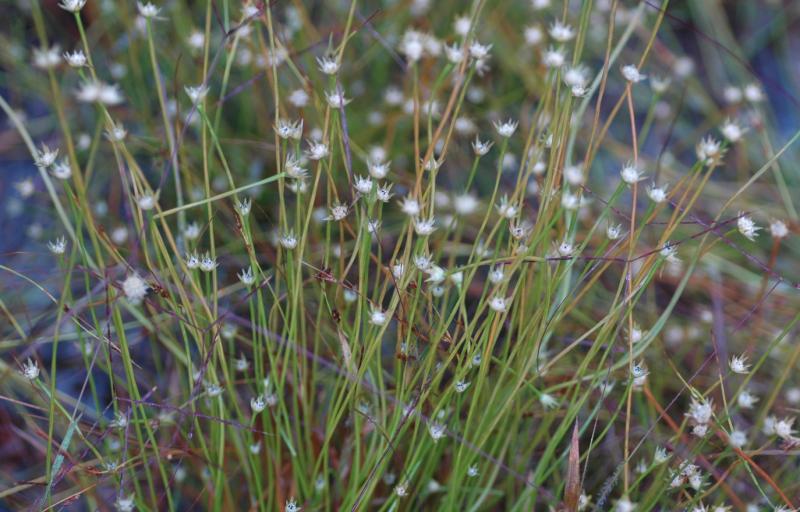
Rice, millets, bamboo, pineapple, bell reed and other economically essential and regularly consumed crops have a thing in common — taxonomically, they all belong to the order Poales of the plant kingdom. Although it has five groups, studies on the evolution of plants under Poales have mostly focused on the Graminids, which includes grasses like maize, wheat, and barley.
In a recent study, researchers from Pune's Agharkar Research Institute and Savitribai Phule University, and China's Zhejiang University have turned their attention towards Xyrids to gain a holistic understanding of the evolution of Poales. This group includes plants like yellow-eyed grass and pipeworts. The study, published in the journal PLOS One, was funded by the Agharkar Research Institute, the Zhejiang Provincial Natural Science Foundation, and the National Natural Science Foundation of China.
The researchers collected leaf samples of Eriocaulon decemflorum, a type of pipewort, from Mt. Dayang in Zhejiang Province, China. While this species is endemic to China, almost one fourth of the species belonging to genus Eriocaulon are found in India, with many being endemic. The researchers studied the genetic sequence of E. decemflorum for the first time and compared it with representatives from the other groups under Poales—Graminids, Bromeliads, Restiids, and Cyprids.
"Many of the Eriocaulon species are known to possess medicinal properties. E. burgerianum is a known neuro-protectant and E. cinereum is known to possess some anti-cancer properties. Moreover, some species are used in the traditional medicinal systems of China to cure various ailments," says Dr Ritesh Choudhary, a researcher associated with Agharkar Research Institute and Savitribai Phule University, and an author of the study.

Eriocaulon decemflorum. Credits - Mr Difei Wu
The researchers then studied the genetic material within a cell's cytoplasmic organelles, known as the plastome, and compared it with the genetic material from three other groups of Poales — Bromeliads, Graminids and Cyprids. These genomes haven't changed much during evolution and hence are ideal for genomic studies. They found two genes — ycf1 and ycf2 — in E. decemflorum that has been lost in Graminids and partially degraded in Bromeliads. These genes are necessary for the plant's survival as they produce crucial proteins. The fact that these two genes are lost sheds light on the evolution of plants belonging to the order Poales through comparison across the constituent groups instead of focusing on one.
While previous studies have looked at the plastomes in Eriocauloideae and Paepalanthoideae, which belong to subfamilies of Xyrids, no research till date has focused on the plastomes of the Eriocaulaceae family to study their genetic evolution and structural content of the plastomes.
"The relationship between Xyridaceae, Mayacaceae and Eriocaulaceae is still not well understood. With the inclusion of more plastome data, our understanding of the evolution of this group will be enhanced," says Ms. Ashwini Darshetkar, a Ph.D. student of ARI working on this project.
The study found that the accD gene, which is vital for photosynthesis and affects leaf development, was lost in Poales after the split between Eriocaulaceae and Xyridaceae. This finding corroborates the findings from another study from 2012. Scientists previously thought that the gene was lost in monocots either before the divergence of the orders Poales and Commelinales or after the split between Cyprids and Xyrids. A functional copy of accD gene was found in the plastome of pipeworts.

Photo credits - Mr Difei Wu
Further, the study looked into two introns—parts of DNA that do not code for any proteins. One such intron was rpoC1, which is necessary for the production of the enzyme RNA polymerase. The other was the introns of clpP, which is a protein-coding gene that assists in chloroplast development. It found that the E. decemflorum plastome contains these introns. In the evolutionary history within Poales, Bromeliads still have the introns and the Graminids have lost them. Functional benefits of presence or absence of these introns in the plastomes of Poales are yet to be explored.
The study results indicate a high degree of similarity between the plastomes of the Eriocaulon and the Bromeliad group. Previous studies on the evolution of the Xyrid group considered the family Eriocaulaceae as a sister of the Xyridaceae family, with little or no connection with the Mayacaceae family. However, the phylogenomic analyses in the present study posit the family Eriocaulaceae as the sister of the Mayacaceae family, a finding that has been supported by other recent studies.
Speaking about the next steps in the team's research, Dr. Choudhary emphasises the need to study the relationship with the Xyrids, specifically between Xyridaceae, Mayacaceae and Eriocaulaceae, to better understand the evolution within the Poales order.
This article has been run past the researchers, whose work is covered, to ensure accuracy.





